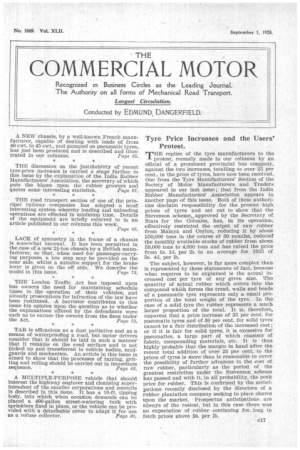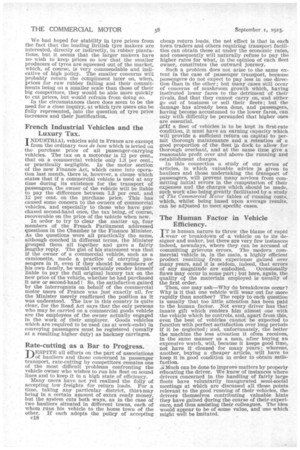Tyre Price Increases and the Users' Protest.
Page 1

Page 2

If you've noticed an error in this article please click here to report it so we can fix it.
rrillE replies of the tyre manufacturers to the -Iprotest, recently made in our columns by an official of a prominent provincial bus company, against the two increases, totalling to over 25 per cent., in the price of tyres, have now been received. One from the Tyre Manufacturers' Section of the Society of Motor Manufacturers and Traders • appeared in our last issue; that from the India Rubber Manufacturers' Association appears in another page of this issue. Both of these authorities disclaim responsibility for the present high prices of tyres and set out to show that the Stevenson scheme, approved by the Secretary of State for the Colonies, has, in its operation, effectively restricted the output of raw rubber from Malaya and Ceylon, reducing it by about 250,000 tops in the course of 30 months, reduced the monthly available stocks of rubber from about 59,000 tons to 4,000 tons and has raised the price from is. Id. per lb. to an average for 1925 of 35. 4d. per lb.
The subject, however, is far more complex than Is represented by these statements of fact, because what requires to be explained is the actual increased cost per tyre of any given size. The quantity of actual rubber which enters into the compound which forms the tread, walls and beads of a pneumatic tyre represents only a small proportion of the total weight of the tyre. In the case of a solid tyre the rubber represents a much larger proportion of the total. It is, therefore, apparent that a price increase of 25 per cent. for pneumatic tyres and of 30 per cent. for solid tyres cannot be a fair distribution of the increased cost ; or if it is fair for solid tyres, it is excessive for pneumatics, a large part of which consists of fabric, compounding materials, etc. It is thus highly probable that the margin in hand after the recent total addition of over 25 per cent, to the prices of tyres is more than is reasonable to cover the possibility of further advances in the cost of raw rubber, particularly as the period of the greatest restriction under the Stevenson scheme has passed and with it, in all probability, the peak price for rubber. This is confirmed by the anticipations recently disclosed by the directors of a rubber plantation company seeking to place shares upon the market. Prospectus • anticipations are always of the rosiest, but in this case there was no expectation of rubber continuing for, long to fetch prices above 2s. per lb. We had hoped for stability in. tyre prices from the fact that the leading British tyre makers are interested, directly or indirectly, in rubber plantations, but it seems that the larger makers have no, wish to keep prices so low that the smaller producers of tyres are squeezed out of the market, which, of course, is very commendable and indicative of high policy. The smaller concerns will probably return the compliment later on, when, prices for raw rubber falling and their commitMents being on a smaller scale than those of their big competitors, they would be able more quickly to cut prices, but would refrain from doing so.
In the circumstances there does seem to be the need for a close inquiry, at which tyre users can be fully represented, into the question of tyre price increases and their justification.




























